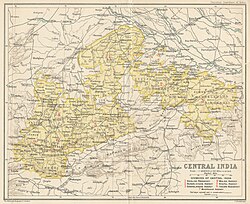
Back ভোপাল রাজ্য Bengali/Bangla Bhopal Catalan Bhopal (Staat) German État de Bhopal French भोपाल रियासत Hindi Bhopál állam Hungarian Negara Bagian Bhopal ID Bhopal (stato) Italian ریاست بھوپال PNB Estado de Bopal Portuguese
Bhopal State | |||||||||
|---|---|---|---|---|---|---|---|---|---|
| 1707[1]–1949 | |||||||||
| Motto: "Nasr min Allah" (Victory from Allah)[2] | |||||||||
 Bhopal State as a part of the Central India Agency. | |||||||||
| Status | State within the Maratha Confederacy (1737-1818)[3] Princely state of India (1818–1947)[4] Unrecognised state (1947–1949) | ||||||||
| Capital | Bhopal (1707-1728, 1742-1949), Islamnagar (1728-1742)[5] | ||||||||
| Common languages | Persian (Official) and Hindustani | ||||||||
| Religion | Islam (minority, but state religion) Hinduism (majority)[6] | ||||||||
| Government | Islamic Principality[7] | ||||||||
| Nawab of Bhopal | |||||||||
• 1707–1728 | Dost Mohammad Khan (first) | ||||||||
• 1926–1949 | Hamidullah Khan (last) | ||||||||
| History | |||||||||
• Established | 1707[1] | ||||||||
• Disestablished | 1 June 1949 | ||||||||
| |||||||||
| Today part of | Madhya Pradesh, India | ||||||||
Statistics from Furber 1951, p. 367 | |||||||||
Bhopal State (pronounced [bʱoːpaːl] ) was an Islamic principality[8][9] founded in the beginning of 18th-century India by the Afghan Mughal noble Dost Muhammad Khan.[10] It was a tributary state within the Maratha Confederacy during 18th century (1737-1818), a princely salute state with 19-gun salute in a subsidiary alliance with British India from 1818 to 1947, and an independent state from 1947 to 1949. Islamnagar was founded and served as the State's first capital, which was later shifted to the city of Bhopal.
The state was founded in 1707 by Dost Mohammad Khan, a Pashtun soldier in the Mughal army, who became a mercenary after the Emperor Aurangzeb's death and annexed several territories to his fiefdom. It came under the suzerainty of the Nizam of Hyderabad in 1723 shortly after its foundation. In 1737, Marathas defeated the Mughals and the Nawab of Bhopal in the Battle of Bhopal, and started collecting tribute from the state.[11] After the defeat of the Marathas in the Third Anglo-Maratha War, Bhopal became a British princely state in 1818. Bhopal State had an area of 6,902 sq. miles in pre-independence India, with a Muslim leadership, first being Hyderabad State. The state was merged into the Union of India in 1949 as Bhopal. In 1901 the state had a population of 665,961 and an average revenue of Rs. 25,00,000.[12]
Bhopal state was unique for a continuous lineage of four female Nawabs who ruled its throne for over a century between 1819 and 1926. During this period, the state was noteworthy for its immense contributions to the development of Islamic religious activities, cultural reform and educational efforts which caused a growing appreciation for its rulers in Indian political circles. Some of the Islamic revival activities of the Bhopal state were met with disapproval by the British authorities.[13]
- ^ Merriam Webster's Geographical Dictionary, Third Edition. Merriam-Webster. 1997. p. 141. ISBN 978-0-87779-546-9.
- ^ Roper Lethbridge (2005). The golden book of India (illustrated ed.). Aakar. p. 79. ISBN 978-81-87879-54-1.
- ^ https://gazetteers.maharashtra.gov.in/cultural.maharashtra.gov.in/english/gazetteer/History%20Part/History_III/chapter_3.pdf
- ^ https://bhopal.nic.in/en/history/
- ^ Singh, Dharmajog, Jogendra Prasad, Anita (1997). City Planning in India: A Study of Land Use of Bhopal. New Delhi: Mittal Publications. p. 28. ISBN 978-81-7099-705-4.
{{cite book}}: CS1 maint: multiple names: authors list (link) - ^ census2011.co.in%2Fdata%2Freligion%2Fdistrict%2F311-bhopal.html%23%3A~%3Atext%3DHinduism%2520constitutes%252074.05%2525%2520of%2520Bhopal%2Csignificant%252022.16%2525%2520of%2520total%2520population.&usg=AOvVaw1P8YWi7aAf62Cpi97eusO3&opi=89978449
- ^ Malik, Jamal; Preckel, Claudia (2000). "The Roots of Anglo-Muslim Co-operation and Islamic Reformism in Bhopal". Perspectives of Mutual Encounters in South Asian History 1760-1860. Koninklijke Brill NV, Leiden, The .Netherlands: Brill. p. 65. ISBN 90-04-11802-0.
- ^ Preckel, Claudia (2000). Begums of Bhopal. New Delhi: Lotus Collection. p. 9. ISBN 81-7436-098-0.
- ^ Malik, Jamal; Preckel, Claudia (2000). "The Roots of Anglo-Muslim Co-operation and Islamic Reformism in Bhopal". Perspectives of Mutual Encounters in South Asian History 1760-1860. Koninklijke Brill NV, Leiden, The .Netherlands: Brill. p. 65. ISBN 90-04-11802-0.
- ^ Preckel, Claudia (2000). Begums of Bhopal. New Delhi: Lotus Collection. pp. 12–13. ISBN 81-7436-098-0.
- ^ https://unacademy.com/content/ca-foundation/study-material/history/battle-of-bhopal/
- ^ "Imperial Gazetteer2 of India, Volume 8, page 125 -- Imperial Gazetteer of India -- Digital South Asia Library".
- ^ Malik, Jamal; Preckel, Claudia (2000). "The Roots of Anglo-Muslim Co-operation and Islamic Reformism in Bhopal". Perspectives of Mutual Encounters in South Asian History 1760-1860. Koninklijke Brill NV, Leiden, The .Netherlands: Brill. pp. 65–66. ISBN 90-04-11802-0.
© MMXXIII Rich X Search. We shall prevail. All rights reserved. Rich X Search

